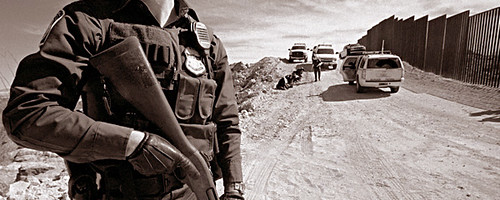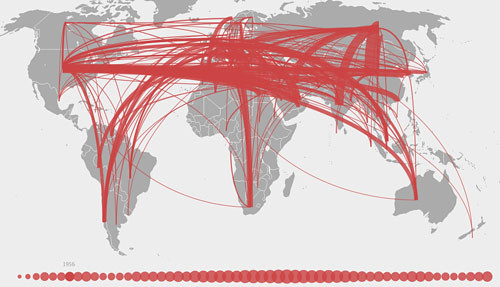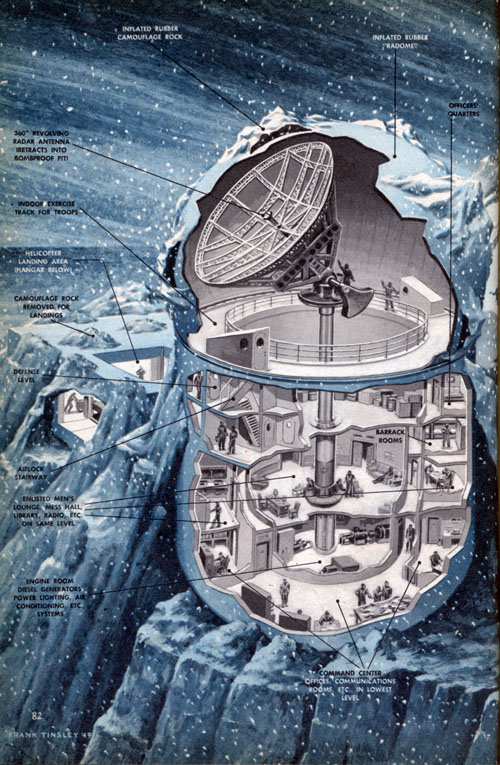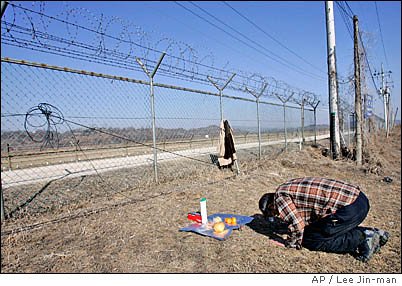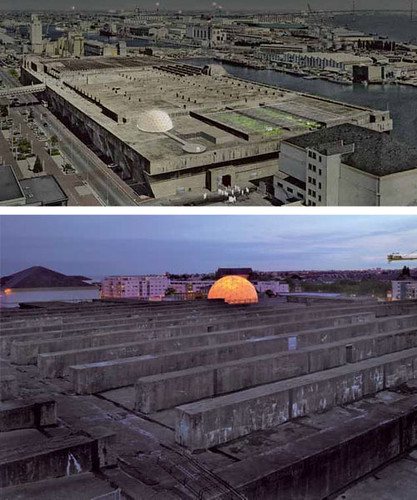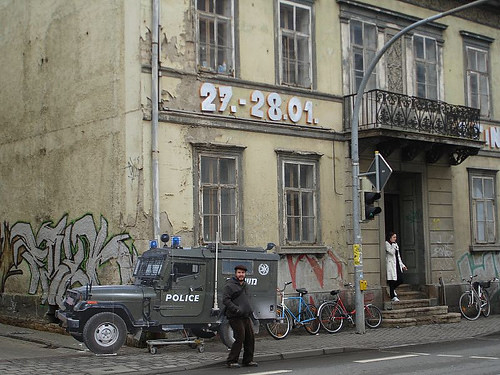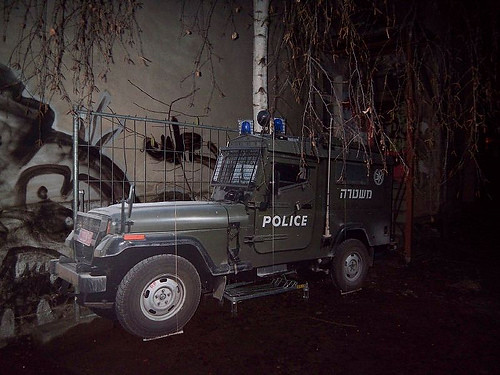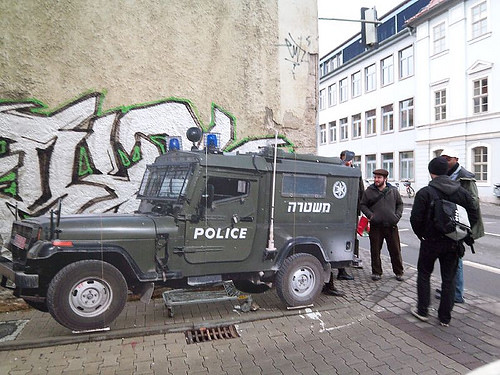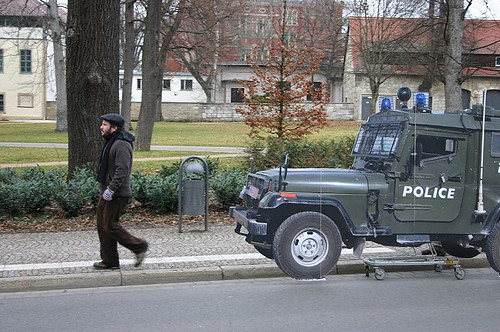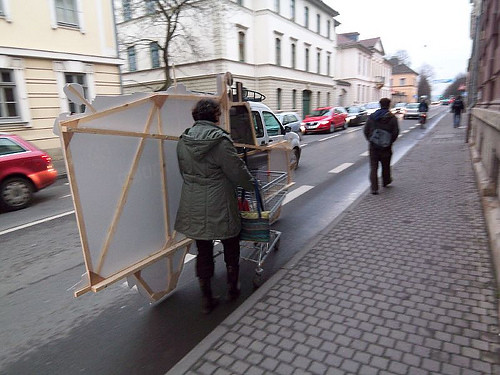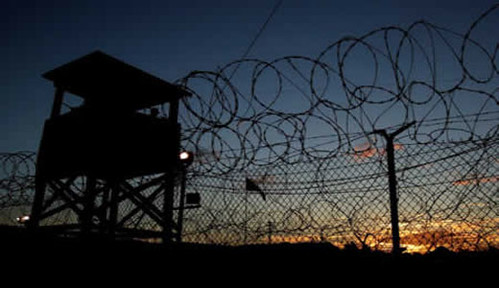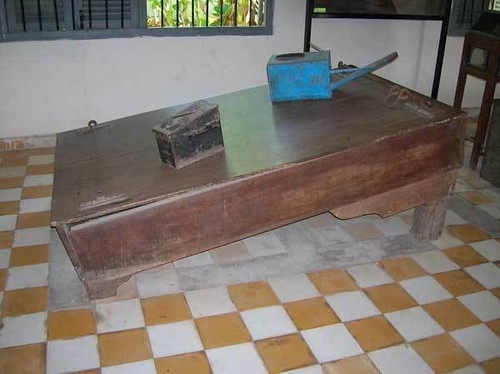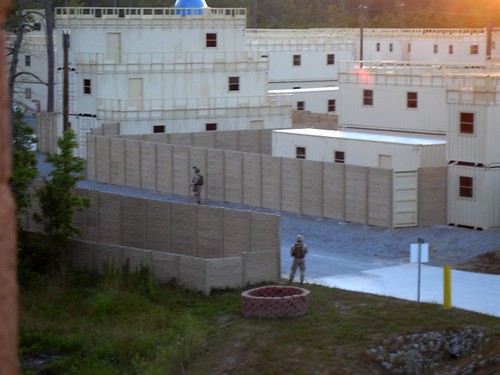 [Image: Mobile MOUT, unknown location.]
[Image: Mobile MOUT, unknown location.]If you’ve been reading
Subtopia for a while now then this may not come as anything new since I’ve called attention before to these mysterious simulacrums of urban space—I’m talking about those ghostly
MOUT (Military Operation on Urban Terrain) training facilities where entire pseudo landscapes and quasi architectures are designed solely for the purposes of being conquered and reconquered, over and over again to help prepare the armed forces for counter-insurgency warfare in cities abroad--life inside a simulative architectural loop; landscape as militaristic prop.
This earlier post
Peering into the Arenas of War should help get you caught up if this is all new to you, as well as these excellent articles both cited in that same post:
Baghdad, USA (Wired), which tours the
Joint Readiness Training Center in Louisiana known as Box, and
Mock Iraqi Villages in Mojave Prepare Troops for Battle (New York Times), that takes a pretty good look at the
National Training Center at Fort Irwin in the Mojave Desert.
 [Image: MOUT Graduate School at Twentynine Palms, CA., as featured in MS&T Magazine/2006.]
[Image: MOUT Graduate School at Twentynine Palms, CA., as featured in MS&T Magazine/2006.]But, as of 2006 a much larger project has been slowly developing just a few miles outside the sprawling Marine Corps Air Ground Combat Center (
MCAGCC) at Twentynine Palms in California, that is estimated—when its all said and done—to be the largest MOUT training facility in the world, and if all goes to plan that could be sometime in the summer of 2010 depending on how far development takes it. Since the MCAGCC site is roughly 932 square miles, (that makes it, according to
this article, “the service’s largest installation, bigger than Camp Pendleton, Calif.; Camp Lejeune, N.C., and Quantico, Va., put together,”) it no doubt provides the ideal geography for essentially recreating entire Arab cities in the American desert so that their future occupation and hostile takeover can be rehearsed and perfected to a kind of act of militaristic performance art, or something.
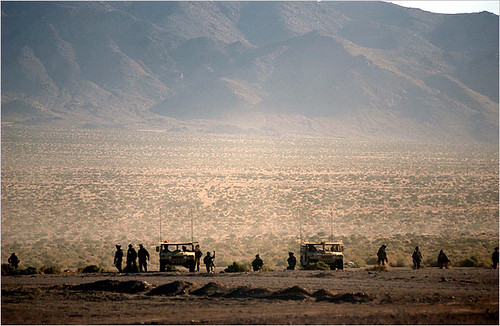 [Image: "U.S. forces arrive to take control of a make-believe Iraqi town. The region, nearly the size of Rhode Island, is dotted with villages that are eerie in their likeness to the real things." - Via NYT, photo by Ann Johansson.]
[Image: "U.S. forces arrive to take control of a make-believe Iraqi town. The region, nearly the size of Rhode Island, is dotted with villages that are eerie in their likeness to the real things." - Via NYT, photo by Ann Johansson.]Somewhere out there in the restricted strata of Defense real estate the Marine Core is taking over cities in an imaginary Third World that have been grafted and turned into some sort of urban template for a spectacularly unseen militarized stage show. There are multiple MOUT facilities all over the world, but in addition to two that already exist at Twentynine Palms, there is a brand new site cropping up along the fringes that’s being called CAMOUT, or Combined-Arms Military Operations in Urban Terrain. Pronounced “K-MOUT”, it is expected to be the Mecca, so to speak, of the entire MOUT program.
A recent and truly excellent
article written by Kelly Sullivan tells us that CAMOUT is “both nowhere and everywhere at the same time.” Lost deep in the American outback early parts of the new site are slated to spread over a 20-by-20 km area centered around an urban core of 280 acres, “roughly the size of downtown San Diego,” Sullivan points out. While this new facility sits tucked away in the nowhere territories of the U.S.’s remote home front, its test grounds for a planetary anywhere where urban warfare mediates the War on Terror lends CAMOUT an eerie ubiquitous everywhere kind of quality. It is, in effect, a stage that is meant to carry out its ultimate theatrics abroad. The essence of MOUT is that it prepares one for the conditions of an elsewhere; it is an active ghost town this way empowering its subjects to descend on cities the other side the world and enact their will wherever they see fit. It is again another manifestation of this military urbanism’s contemporary elasticity; it is the capability of bringing the complexities of a foreign city home in order to practice the art of conquering it there first. It is an eerie simulated architectural sublime in the art of war.
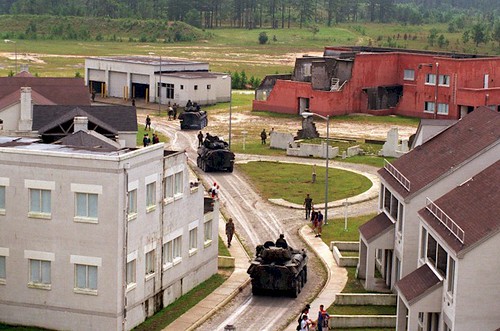 [Image: NATO Exercise Cooperative Osprey 1996, Camp Lejeune, NC.]
[Image: NATO Exercise Cooperative Osprey 1996, Camp Lejeune, NC.]CAMOUT is being built in three phases over three years with separate funding contracts that could reach in total somewhere between $200 and $250 million — “the largest within the Department of Defense" with regards to a so-called
MOUT urbanism.
The first phase is the construction of the urban core which Sullivan goes on to tell us “will feature an Olympic-size soccer stadium, a hospital, airport, large marketplace, prison, police compounds, schools, an industrial center, extensive underground tunnel systems and two embassies.”
Quoting the article at length, here's a brief overview on the development of the MOUT program:
By 2015, an estimated 75 percent of the world’s population will live in urban areas, Robertson said.
In 1997, according to Department of Defense documents online, the Marine Corps Warfighting Laboratory in Quantico, Va., began studying urban warfare environments.
In 1999, it launched Project Metropolis to develop a program to help Marines fight successfully in such environments.
A project study determined that urban training facilities, which have been in use for many years by the Marine Corps at its various bases, were too small. Many contained 35 or fewer buildings, Robertson said (Bryan Robertson – Assistant CAMOUT Project Manager), hardly enough to provide the level of training needed to prepare troops to conduct operations in big cities.
“Trying to train for urban combat in 35 buildings is like trying to train for jungle warfare in a botanical garden,” he said.
And so the idea of a mega-MOUT, one big enough to accommodate a full Marine Air-Ground Task Force — 7,000 troops — was born.
In 2004, the Marines began developing the concept and design for CAMOUT, putting together a budget with funding from two sources — military construction funds and military procurement funding.
So, what will a quarter of a billion dollars get you? Well, reading on we learn CAMOUT, if completed as planned, will include 1,560 buildings (some as high as five stories) in seven separate districts: the urban core (as previously described), east and west stadium districts, a hospital district, an ‘old town’ which will actually be modeled on Sadr City (a suburb of Baghdad), and finally an industrial district as well as a diplomatic district. “A city like no one has ever seen,” it will be “bisected by a river, already in place, that’s up to 80 feet wide in some spots,” even though in reality we are told it will contain absolutely no water. “Some areas will have buildings that have been reduced to rubble and there will be shanty towns around the city” that will almost certainly lend a theme park-like and surreal credence to Mike Davis’ claim that the
Pentagon is the world’s largest slumlord.
 [Image: "At the National Training Center at Fort Irwin in the Mojave Desert, the Army is relearning how to fight, shifting from its historic emphasis on big army-to-army battles to the more subtle tactics of defeating a guerrilla insurgency." - Via NYT, photo by Ann Johansson.]
[Image: "At the National Training Center at Fort Irwin in the Mojave Desert, the Army is relearning how to fight, shifting from its historic emphasis on big army-to-army battles to the more subtle tactics of defeating a guerrilla insurgency." - Via NYT, photo by Ann Johansson.]Each of these districts is meant to provide a different urban experience, to command a distinct military interface with the separate layers of what constitutes the medium of an
urbanized insurgency, in varying spatial densities and typologies, and for a range of tactical purposes, from targeted assaults, patrolling techniques, clearing buildings, rescue missions, to more scaled mass evacuations and stationary support roles. There will be an entire system of underground sewers so soldiers at CAMOUT will be able to train for a new wave of subterranean warfare, as well as coordinating large-scale air/ground operations. All the while this entire ‘combat city’ will be covered in cameras that will be controlled remotely and allow everything to be watched, recorded, and used for playback, in what Geoff has
described in his own MOUT coverage as
a cinematic extension of the architectural war environment.
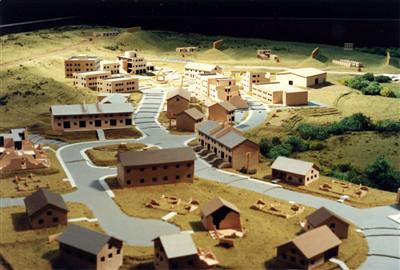 [Image: Model of the Urban Training facility, via Soltek.]
[Image: Model of the Urban Training facility, via Soltek.]And so, you might be wondering who actually builds these things, who gets the contracts to design and erect these artificial marvels of the Third World, these ‘
feral city’ replicas? Who designs the militarized theme parks of the Marine Core’s industrial combat training grinder? In this case, I’ve found it’s
Soltek Pacific, a San Diego based design-build construction company that’s using the help of Architects Mosher Drew Watson and Ferguson, and Stedman & Dyson Structural Engineers. These are the architects re-imaging the imaginary geographies of the non-western world, building the play sets of war, the precursory battlegrounds of the future. It’s a crazy prospect to think about, particularly: what are the psycho-urban implications of training soldiers in certain mimicried environments like these? Even though these places provide immersive cultural training and ways of interfacing with foreign places and people, how do these arenas for war-play also actually condition to some extent our military’s racial perception of the Arab—or, the ‘other’—world? What inherent racism exists in the fabricated architectures of mock Iraqi villages set out as mere objects of war across the innocuous flatness of the Mojave desert? Are these the disposable architectures of a new racialized landscape; the subliminal artifice of geopolitical brainwash; are they the ultimate spatial commodities of a new MOUT marketplace?
 [Image: Mobile MOUT, unknown location.]
[Image: Mobile MOUT, unknown location.]There is
Mobile MOUT, reconfigurable shipping containers that allow these training facilities to both be transported and adapted to multiple spatial arrangements to mix up the architecture a bit for training purposes, but one can only wonder how reconfigurable these simulated cities may actually become in the future. The idea that CAMOUT could one week be fancied into a city based on the exact dimensions of Sadr Cty, and then the next week be converted into a startlingly real carbon copy of Port-au-Prince, or Darfur, smacks of both exciting and sinister potential. Imagine an entirely fake city that is the architectural combination of, say, Rio, Tijuana, and Johanasberg—toy cities, hybrid cities; imagine the Lego cities of anti-western extremism and other counter imperialist pirates coming to life. CAMOUT is a city waiting not only to be destroyed over and over again, but one eager to be remade in the alternating images of Third World cities all over. It is a morphable chameleon this way. Freaky, right?
Or, imagine—in the event this base remains an unchanged replica of a single city—if a brand new geography of CAMOUTs one day spanned the Pentagon’s
real estate portfolio around the world, so that dozens of global south cities come to have life-sized replicas of themselves opposite sides of the planet being colonized by Marine Core drill sergeants and the impresarios of globalization’s military machine. Is this the Universal Studios of nation building? What if these dispersed bases even became a a bizarre kind of global tourist market and families from all over came to ride armored trams through gridded sets of fake battle scenes and spectacularly contained skirmishes, glimpsing up close the wars of the future? What if these military bases were the vanguard of architecture’s simultaneous progression and regression? What if CAMOUT became a new dismal suburban model of sorts for the future?
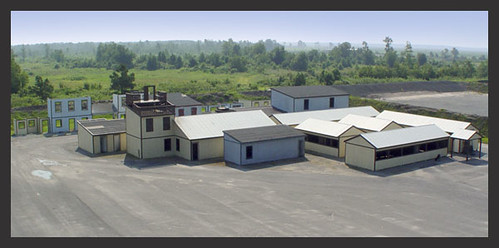 [Images: Blackwater Training facility in North Carolina, compliments of www.blackwaterusa.com.]
[Images: Blackwater Training facility in North Carolina, compliments of www.blackwaterusa.com.]While the military contractor company Blackwater can boast having
the world’s largest privately owned military base in the world, CAMOUT is now on its way to becoming the federal equivalent. And even if all three phases of it are built I can’t help but to wonder, what will be the next phase after that? What will constitute the urban evolution of MOUT? While these facilities mostly occupy remote exurban locations today, what will be the next dimension of MOUT's advancement tomorrow? What is the ultimate architectural trajectory of this program--bases the size of small countries? Will MOUT one day see its infusion somehow into our normal lives, into the fabric of our common society? In other words, will MOUT one day expand to a utilization of real-life western cities? Could San Francisco, or Los Angles become the next vast training facility? Or, will MOUT take over abandoned tracts of other American real estate as a sort of advantageous byproduct of the shrinking city phenomenon we see in places like
Flint, or abandoned stretches of McMansions from the dismal
subprime housing market crisis? This may sound absurd, but might we all one day end up living as the unwitting actors within a Goliath-scale MOUT urban program?













